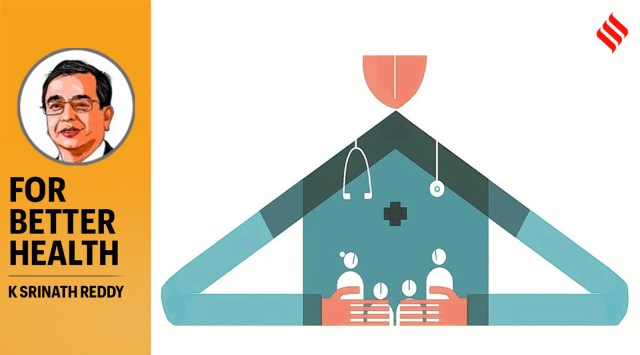
India’s aspiration to become an economically developed nation by 2047 is intertwined with the goal of having a healthy and productive population. Even as current challenges to health call for continued attention in 2025, newly emerging and anticipated future threats to population health must be countered from now on. While health promotion and disease prevention must be accorded high priority at the population level, disordered health of individuals must be speedily restored through efficient and equitable delivery of diagnostic and therapeutic services. If such a robust health system is to function with youthful vigour in 2047, it should spring to life in 2025. The double helix of financial and human resources must provide the DNA for its growth and development.
Primary healthcare-led universal health coverage (UHC) is the vehicle on which our health systems must drive towards 2047. This requires higher levels of public financing, with a rise in allocations across central and state budgets. For achieving UHC, we must simultaneously perform well on two sets of indicators — financial protection and service coverage. We need to ensure that health services across the country can delivering a wide range of quality assured health services to meet age relevant health needs of all families. This calls for a multi-layered, multi-skilled health workforce that is well distributed across India. Given shortages of highly-skilled doctors and the time lag for bridging those gaps, the immediate priority is to train a large number of technology-enabled frontline health workers and allied health professionals.
The Ayushman Bharat mission has the key components needed to create the template for an effective, equitable, economically efficient and empathetic health system: Upgraded primary care architecture; health infrastructure; financial protection for healthcare expenses of socio-economically vulnerable and aged population groups and a digital health technology thrust to integrate many functional units of the health system. We now need to connect these different components to create a powerful thrust engine for propelling the country towards the goal of a healthy India. The role of the digital health mission becomes especially important in this endeavour, extending as it does from epidemiological intelligence to monitoring the impact of health programmes.
Major health indicators vary across districts, states, socio-demographic and gender groups. While India’s health indicators are often described in aggregate terms, we need disaggregated data at district and block level for actions that are evidence informed, context relevant, resource optimising, culturally adaptive and equity promoting. We need to transform the disparate data systems that exist now into integrated systems capable of providing timely, representative and accurate data.
Such data are essential in times of accelerating epidemiological transition, when non-communicable diseases (NCDs) and mental health disorders have overtaken the combined disease burdens of infectious diseases. NCDs are rising in magnitude and account for two-thirds of all deaths, many of which occur in productive mid-life years.
Data on diseases and their risk factors (incidence, prevalence, time trends) need to be gathered for both infectious diseases and NCDs. Presently, the NCDs and their risk factors are mapped through sporadic regional surveys. While the integrated disease surveillance programme (IDSP) provides data on some infectious diseases through sentinel sites, the rapid rise in zoonotic diseases calls for extensive and real-time surveillance data.
Techniques such as wastewater surveillance must become a routine part of our surveillance, both for early detection of emerging microbial threats and for monitoring levels of antimicrobial resistance (AMR). Climate change is now opening the tap of water-borne diseases and giving wings to vector borne diseases. These threats call for more vigilant surveillance systems.
The danger of zoonotic diseases, extending from national outbreaks to global pandemics, calls for integration of microbial surveillance systems across several species of wild life, captive bred and free living veterinary populations as well as stable and migrant human communities. The “One Health” approach calls for such data integration across species and geographies, while also studying the impact of changing climatic conditions (rising heat and extreme weather events). Big data analytics will need to be at the heart of infectious disease surveillance.
Even for patient care, efficiently integrated data systems are needed. Different sets of diagnostic and treatment-related data need to be combined and correlated, even within a single institution. When patients move from one healthcare facility to another, with or without referral, lack of data transfer and ineffective integration of essential information obfuscate diagnostic assessment and impede rational treatment choices. These disconnects also violate the patient’s right to full information on his or her health condition.
While the digital health mission is being progressively integrated into the government funded and operated public health and healthcare systems, most private healthcare facilities have not actively embraced it. That creates huge disconnects in India’s mixed health system. That is detrimental to the delivery of appropriate and affordable healthcare at the population level and can endanger the health of individual patients.
It is essential to use the digital strengths of India to bridge the disconnects between primary care and publicly funded health insurance programmes that support secondary and tertiary hospital care (like PMJAY and state health insurance programmes). Digital data banks must connect public and private sector data repositories and referral systems. This will enable artificial intelligence to be applied to large Indian data sets to develop contextually relevant diagnostic and clinical management algorithms. Community participation, whether for crowdsourcing surveillance data during outbreaks or for reporting glitches in programme implementation, can also be digitally enabled. Will 2025 provide the impetus to a digitally assisted transformation of our health system?
The writer is distinguished professor of Public Health, PHFI and author of Pulse to Planet. Views are personal